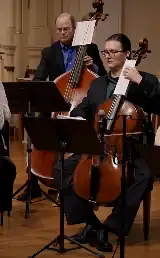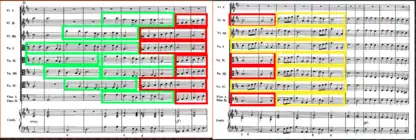
Battalia à 10 is a piece of chamber music written by the Bohemian-Austrian composer Heinrich Ignaz Franz Biber. The work is known for its early use of polytonality and non-conventional techniques. Written in 1673,[1] Battalia is scored for 3 violins, 4 violas, 2 violones, and continuo.
History
Even though Biber's reason of the Battilia is uncertain, some scholars say it was the composer's feelings toward the Thirty Years' War, probably due to the high casualties (~50% of the German population and 1/3 of the Czechs).[2]
Analysis
Sonata (Presto I)
The Sonata is in AB form; the B section uses a call and response motif, the response of which uses a staccatissimo mark to signal col legno or to hit the string with the back of the bow.
Die liederliche Gesellschaft von allerley Humor (The Profligate Society of Common Humor)
The most famous, the second movement incorporates 8 melodies, but in different key and time signatures. One of the melodies is the folk song, "Cabbage and turnips have driven me away", similarly used in Bach's 30th Goldberg Variation, or the Quodlibet. Also some measures are in 12/8 time and the others in 4/4 time. There is a Latin footnote that reads hic dissonant ubique, nam enim sic diversis cantilenis clamore solent or "here it is dissonant everywhere, for thus are the drunks accustomed to bellow with different songs"
Allegro (Presto II)
The form is A-A-B-B, and uses left-hand pizzicato, which is indicated with a staccato dot. The movement feels irregular, calling back to the war feeling, maybe symbolizing "uneasiness that the troops have inside them waiting for battle, while on the outside they show a sense of frivolity"
Der Mars (The March)

Der Mars uses a particular paring of violone and solo violin. While the violin is playing trills and ornaments, the violone is instructed to imitate the sound of a snare drum by placing a sheet of paper between the strings and the fingerboard.
Presto III
The third presto is canonic in nature with one interlocking theme with accompaniment as shown by the diagram at the bottom at this page.

Aria
Die Schlacht
Lamento Adagio
References
- ↑ Meyer, Douglas (2015-01-14). "Heinrich von Biber: Battalia à 10 | Douglas Meyer". Retrieved 2023-05-29.
- ↑ Wolfman, Gary. Battalia by Heinrich Ignaz Franz Biber. CMP Teaching Plan.